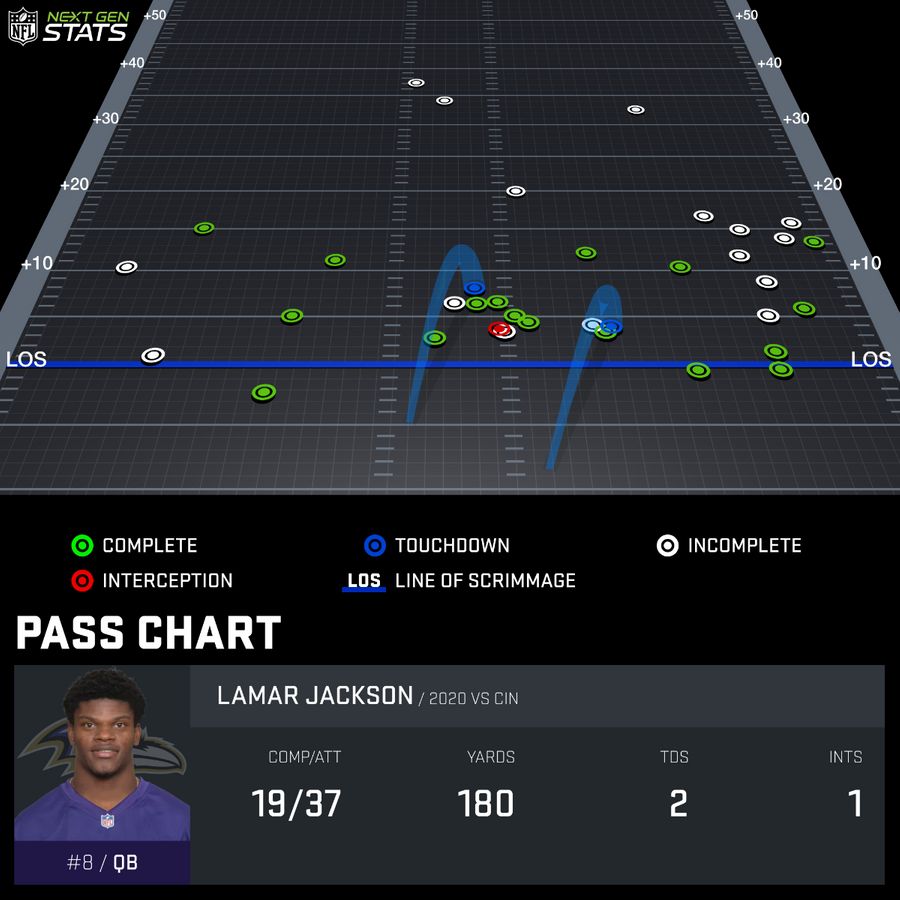Though the Baltimore Ravens picked up another win, beating the Cincinnati Bengals in Week 5, the offense was far from the unit we all saw last season. After a 2019 campaign that broke records and earned quarterback Lamar Jackson an MVP award, Baltimore’s offense has been far more inconsistent in the early part of the 2020 NFL season.
One of the reasons might just be who Jackson turns to first when throwing the football. Astute fans might recognize that wide receiver Marquise Brown and tight end Mark Andrews lead the way in all receiving categories for the Ravens, and by a pretty wide margin. Brown leads everyone on Baltimore’s roster in targets (36), receptions (22), and receiving yards (319) while Andrews tops the charts with five touchdown catches, coming in at a close second in every other receiving category.
Unfortunately, Ravens fans aren’t the only people taking notice of where the ball is going. Following the game, Bengals safety Jessie Bates III and linebacker Logan Wilson both noted it’s the Brown and Andrews show through the air. Though both admitted Cincinnati’s defense didn’t do enough to completely shut both passing targets down, Wilson pointed to a far different second half for Jackson when they were able to slow Andrews and Brown down.
“It’s just as simple as not letting him get the ball,” Bates said about Andrews after Sunday’s game. “We know where Lamar wants to go: either ’15’ [Marquise Brown] or ’89’ [Mark Andrews]. It showed up today as well. That’s all he was really throwing to, was ’15’ or ’89.'”
“He’s Lamar’s go-to target,” Wilson said when asked about shutting Andrews down in the second half. “I think everyone knows that, especially in the red zone. So, we needed to adjust to that, knowing where he’s going to be, Lamar is going to be looking for him. Like I said, I think we adjusted to that in the second half.”
Both Bengals defenders have a solid point and the evidence backs them up. Jackson went 8-of-13 for 76 yards, and two touchdowns in the first quarter (one play into the second quarter really). But things slowed down quickly for Baltimore’s passing attack once Cincinnati was better able to lock up Andrews and Brown beyond that.
After going 6-of-9 for 56 yards and a touchdown in the first half, Andrews didn’t receive a single target in the second half. Brown caught 5-of-7 targets for 42 yards and a touchdown in the first half. But things dramatically switched up in the second half where Brown was targeted just three times, catching two passes for 35 yards, including one catch-and-run that went for 30 of those yards. Meanwhile, after going 16-of-28 for 137 yards, two touchdowns, and one interception in the first half, Jackson went 3-of-9 for 43 yards in the second half.
On the day, Jackson completed just 19 of his 37 targets (51.4%) for 180 yards, two touchdowns, and an interception. While those stats might not seem awful, Jackson’s 4.86 yards-per-attempt for the game is the third-lowest of his 27 career starts. And anyone watching Sunday’s game likely noticed the Bengals could have easily come down with another two or three interceptions if defenders could catch a ball thrown right into their chest.
It’s not as simple as Jackson just pinpointing two receivers, however. Something many young quarterbacks struggle with at the beginning of their careers is throwing outside the numbers. Outside passes have to have a lot more touch, the timing is even more important, and it’s typically where the best defensive backs are going to be.
Bates was on top of that tendency as well. When asked how Cincinnati’s defense tried to force Jackson to throw outside the numbers, Bates said the gameplan was to load up the middle of the field “where all their completions come from.” Taking a quick look at Jackson’s passing chart for the game only proves Bates’ point, with every deep shot and a majority of the outside throws falling to the turf.

If you’re an opposing defensive coordinator, it seems as though Bates and Wilson just drew up your gameplan against Baltimore until Jackson steps up his game and can beat it.
It might not be fair to put all the blame on Jackson here. Offensive coordinator Greg Roman is also partly responsible, as are the other receiving targets who have struggled to get open, and the rushing attack that has been just average this season. It’s also worth noting that with a condensed offseason and no preseason games due to the coronavirus pandemic, Jackson and this offense are still clearly working on things like timing and chemistry.
But at the same time, Jackson is the Ravens’ franchise quarterback and is fresh off an MVP season. We all know he can play better football than this but it’s up to him to actually do it. In Week 5, Jackson missed a few wide-open receivers, instead, trying to target his favorites or looking for a deep ball that wasn’t within a country mile of his intended target. Whether it’s a knee injury that is hampering him more than anyone is letting on, or a desire to try and prove his toughest critics wrong, Jackson isn’t playing smart or consistent football right now.
The Ravens got lucky the last two weeks and they’ll face another relatively easy opponent in Week 6 in the 1-3-1 Philadelphia Eagles. But with a schedule that quickly gets tougher following that, Jackson has very few weeks to either improve as a passer or get smarter about where he’s throwing the ball, or Baltimore could start chalking up losses.
[vertical-gallery id=54221]
